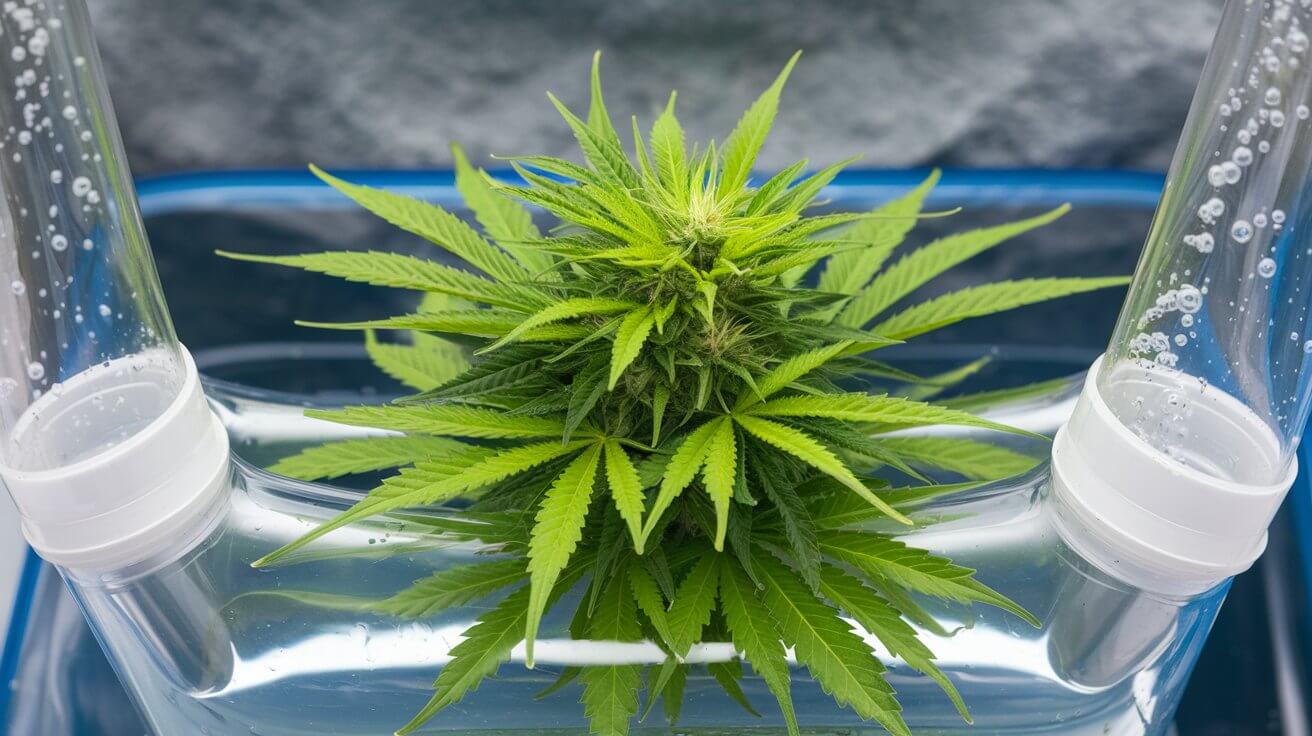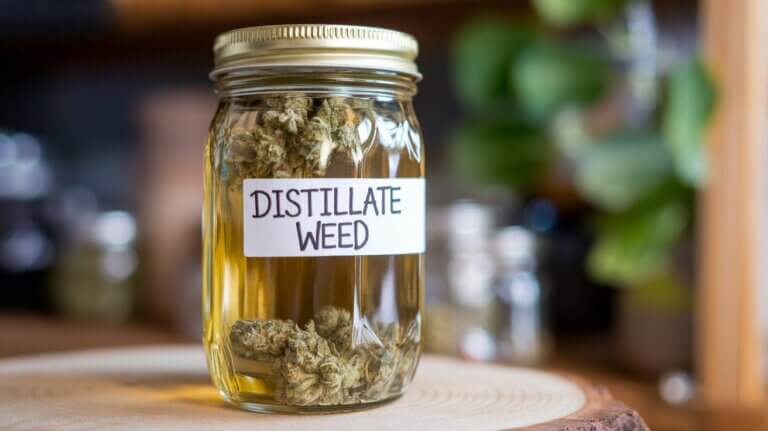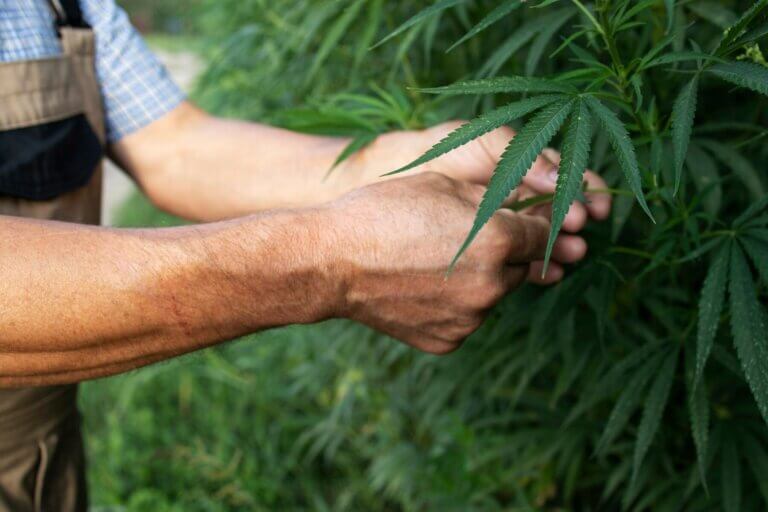From Seedling to Harvest: 7 Steps to Master Hydroponic Weed Growing
Introduction
Hydroponic weed growing is transforming the way cannabis is cultivated. By growing weed without soil, you can achieve healthier plants, faster growth, and higher yields. Whether you’re a hobbyist or looking to start a small-scale cannabis cultivation operation, hydroponics is an excellent choice. This guide will walk you through everything you need to know to get started with hydroponic weed growing, from choosing the right system to troubleshooting common issues.
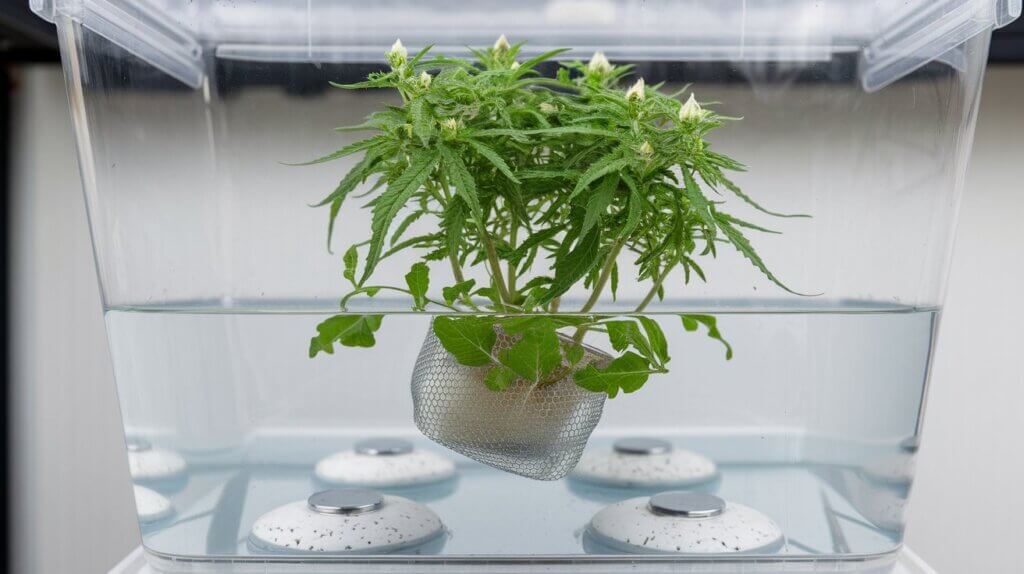
What is Hydroponic Weed Growing?
Hydroponic weed growing refers to the practice of growing cannabis in a water-based, nutrient-rich solution rather than traditional soil. This method allows plants to absorb nutrients more directly, leading to faster growth and more controlled environments. Since the cannabis plants do not rely on soil, they often grow healthier and more robust, with the added benefits of higher yields and reduced risk of pests and diseases.
Why Hydroponic Weed Growing?
- Faster Growth: Plants in a hydroponic system grow up to 25-30% faster than those in soil because the roots have direct access to nutrients and oxygen.
- Higher Yields: With the precise control of nutrients and environmental factors, hydroponics can yield more abundant harvests.
- Water Conservation: Hydroponic systems use up to 90% less water than traditional soil cultivation methods.
- Space Efficiency: Perfect for indoor setups, hydroponics saves space by allowing vertical growing and reducing the need for large plots of land.
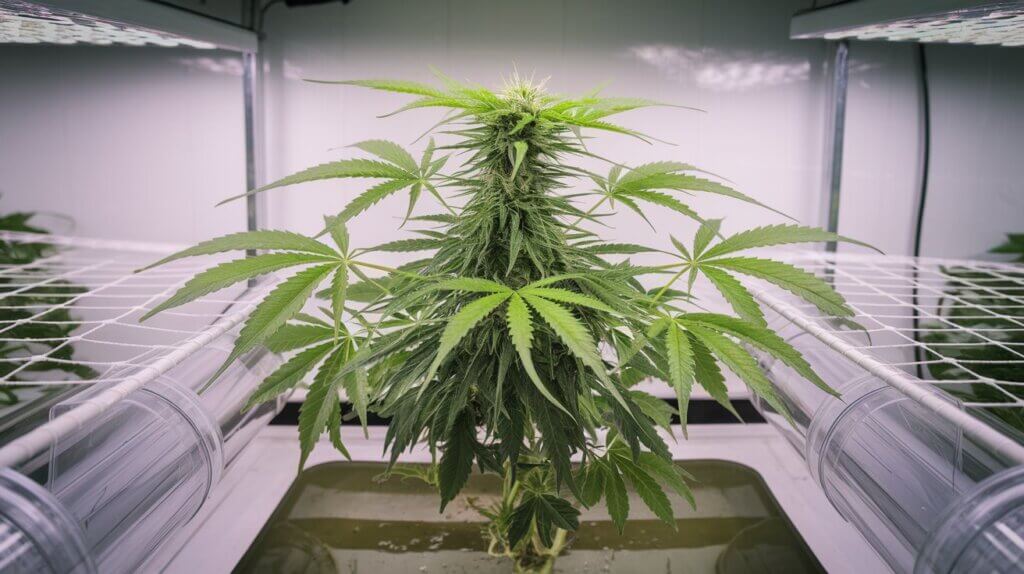
Types of Hydroponic Systems for Growing Weed
Several hydroponic systems can be used to grow weed, each offering unique benefits. Let’s take a look at some of the most popular systems for hydroponic weed growing:
Deep Water Culture (DWC)
- How It Works: In this system, cannabis plants are suspended in a nutrient-rich solution. Their roots are submerged in water, and an air pump provides oxygen to the roots to ensure they don’t drown.
- Pros: DWC systems are simple to set up, highly efficient, and ideal for beginners. They encourage rapid growth and produce strong, healthy plants.
- Cons: This system requires consistent monitoring of pH and nutrient levels, and you must ensure that the water stays well-oxygenated.
Wick System
- How It Works: The wick system uses a wick (such as cotton or nylon) to draw nutrient solution up from a reservoir and into the growing medium, where the plant roots absorb the water and nutrients.
- Pros: Easy to set up and doesn’t require electricity, making it a good choice for small indoor or outdoor setups.
- Cons: Less efficient for larger plants or systems that require high water and nutrient usage.
Nutrient Film Technique (NFT)
- How It Works: This system continuously pumps a thin film of nutrient solution over the plant roots. The solution runs in a shallow stream, allowing the roots to absorb nutrients while exposed to oxygen.
- Pros: NFT is efficient and scalable, making it a popular choice for larger cannabis grows.
- Cons: It can be more difficult to maintain, especially when dealing with larger plants that need more nutrients.
Flood and Drain (Ebb and Flow)
- How It Works: The flood and drain system periodically floods the grow tray with nutrient solution, then drains it back into the reservoir. The process ensures that the roots have access to both nutrients and oxygen at different times.
- Pros: Suitable for large plants and can work well for cannabis varieties that require more space.
- Cons: Needs regular monitoring to ensure that the system is draining and flooding properly, especially if you’re working with multiple plants.

Essential Equipment for Hydroponic Weed Growing
Before you start your hydroponic weed garden, you’ll need some basic equipment. The right tools ensure healthy plants and efficient growth. Here’s what you’ll need:
Grow Trays and Containers
You’ll need a container to hold your plants and the nutrient solution. Depending on the hydroponic system you choose, this could range from small trays for a Wick system to larger reservoirs for a DWC setup.
Growing Medium
Since you’re not using soil, you’ll need an alternative growing medium to provide structure and support for the plants. Popular options include:
- Rockwool: Offers excellent water retention and aeration.
- Coco Coir: A sustainable and lightweight option that’s great for retaining moisture.
- Hydroton: Clay pellets that offer great drainage and air circulation.
Nutrient Solution
Cannabis requires a balanced mix of macro and micronutrients, including nitrogen, phosphorus, potassium, calcium, and magnesium. Hydroponic nutrient solutions are specifically designed for hydroponic weed growing, ensuring plants receive optimal nutrition. Be sure to choose a formula that is designed for the growth stage (vegetative vs. flowering) of your cannabis plants.
pH Meter and EC Meter
Maintaining the right pH (usually between 5.5 and 6.5) is essential to ensure nutrient uptake. A pH meter will help you keep track of the water’s acidity. An EC (electrical conductivity) meter will measure nutrient concentration, helping you maintain an ideal solution strength.
Grow Lights
Cannabis plants need strong light, especially in indoor environments. Common lighting options include:
- LED Grow Lights: Energy-efficient, long-lasting, and low-heat, making them ideal for smaller, indoor grows.
- High-Intensity Discharge (HID) Lights: Offer intense light, but produce more heat, requiring better ventilation.
Air Pump and Stones
If you’re using a DWC or other water-based system, you’ll need an air pump and air stones to provide oxygen to the roots. Oxygenated water is essential for healthy root development and overall plant health.
Setting Up Your Hydroponic Weed System: A Step-by-Step Guide
Setting up a hydroponic weed garden involves a few essential steps. Here’s a detailed guide to help you get started:
Step 1: Choose Your Hydroponic System
Decide on the type of hydroponic system that best suits your needs and space. For beginners, Deep Water Culture (DWC) or a Wick system is recommended for their simplicity.
Step 2: Select the Right Location
Choose a location that offers optimal light and temperature control. An indoor setup should have access to at least 12-16 hours of light per day, while an outdoor setup should ideally be in a spot with good sunlight.
Step 3: Assemble Your Equipment
Set up your hydroponic system, ensuring all components (reservoir, grow tray, air pump, and lights) are securely in place. Make sure the reservoir is large enough to support your plants and their water needs.
Step 4: Prepare Your Nutrient Solution
Mix your hydroponic nutrients according to the manufacturer’s instructions. Use distilled or purified water to prevent the introduction of contaminants. Check the pH and EC levels, adjusting as necessary to ensure your cannabis plants are receiving the proper nutrients.
Step 5: Add Your Cannabis Plants
You can start with seedlings or clones. Place them in your chosen growing medium and ensure the roots are in contact with the nutrient solution. Be careful not to submerge the roots too deeply (unless using DWC) as they need access to oxygen.
Step 6: Monitor and Adjust Regularly
Hydroponic weed growing requires constant monitoring. Check the pH and nutrient levels daily, ensuring the solution is balanced and plants are growing well. Keep an eye on water levels, lighting, and any potential pest issues.
Troubleshooting Common Hydroponic Weed Growing Problems
Nutrient Deficiencies
Cannabis plants are susceptible to nutrient deficiencies if the pH or EC levels are off. Common symptoms include yellowing leaves (nitrogen deficiency) or brown tips (potassium deficiency). Regular monitoring of pH and EC can help prevent this.
Root Rot
Root rot can occur in water-based systems if the water is stagnant or lacks oxygen. Ensure you have a functioning air pump and that your water is well-oxygenated. Keep your reservoir clean and change the water regularly to avoid buildup.
Light Burn
If your grow lights are too close to your plants, you may experience light burn, causing leaves to turn crispy or brown. Adjust the height of the lights to ensure your cannabis plants receive adequate light without burning.
Best Cannabis Strains for Hydroponic Growing
Certain cannabis strains thrive in hydroponic systems, particularly those that are fast-growing or require precise environmental control. Here are a few top choices:
- White Widow: Known for its resistance to pests and diseases, this strain grows well in hydroponic systems.
- Northern Lights: A compact, robust plant that responds well to hydroponics, producing high yields.
- Blue Dream: Popular for its resilience, Blue Dream adapts well to hydroponic environments and produces abundant, potent buds.
Conclusion
Hydroponic weed growing offers an exciting and highly efficient method for cultivating cannabis. With the right system, equipment, and care, you can experience faster growth, larger yields, and higher-quality buds. Whether you’re growing for personal use or starting a small-scale cannabis operation, this guide provides everything you need to get started. So, set up your hydroponic system today, and enjoy the benefits of this innovative gardening method.
FAQ’s
What is hydroponic weed growing, and why is it beneficial?
Hydroponic weed growing involves cultivating cannabis plants without soil, using a nutrient-rich water solution. This method offers benefits like faster growth, higher yields, and precise control over nutrients, making it a preferred choice for many growers.
What equipment do I need to start hydroponic weed growing?
You’ll need a hydroponic system (e.g., DWC, NFT, or drip system), grow lights, a pH and EC meter, water reservoir, air pump, nutrient solutions, and growing medium (like clay pebbles or rock wool). Proper ventilation and monitoring tools are also crucial.
How do I choose the best hydroponic system for growing cannabis?
The choice depends on your experience level, budget, and space. Beginners often start with Deep Water Culture (DWC) or a simple drip system, while more experienced growers might prefer advanced systems like Aeroponics or NFT for optimized growth.
What type of lighting is best for hydroponic cannabis plants?
LED grow lights are popular for hydroponic cannabis due to their energy efficiency, low heat output, and customizable light spectrums. High-Pressure Sodium (HPS) and Metal Halide (MH) lights are also effective but produce more heat and consume more energy.
How often should I check and adjust the pH levels in a hydroponic system?
pH levels should be checked daily to ensure they remain between 5.5 and 6.5 for optimal cannabis growth. Regular monitoring prevents nutrient lockout and ensures healthy plant development
What are common challenges in hydroponic weed growing, and how can I avoid them?
Challenges include nutrient imbalances, pests, root rot, and pH fluctuations. Avoid these by maintaining a clean system, monitoring water quality, using beneficial microbes, and ensuring proper aeration and drainage.
How long does it take to grow cannabis from seedling to harvest using hydroponics?
The duration varies depending on the strain, but typically, cannabis grown hydroponically can go from seedling to harvest in about 3 to 4 months, with faster vegetative and flowering stages compared to soil-based growing
